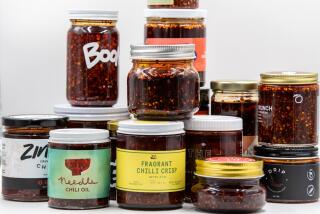The Colorful Asian American Life Is One for the Books : Publishing: A new encyclopedia touches on religion to culture to Kristi Yamaguchi. Will it be ‘a resource for everyone’?
- Share via
Somewhere during the three years he spent editing the new Asian American Encyclopedia, Franklin Ng realized he’d undertaken a labor of love.
“I had been entertaining this idea on and off for a long time,” says Ng, an anthropologist and historian at California State University, Fresno. “I had been thinking of writing a book on the subject or some kind of reference work.”
But when Ng, 48, found himself spending long hours on the phone and traveling to academic conferences to persuade colleagues to contribute, he knew he had embarked on a huge undertaking.
The hard work was not for nought.
“I think people will find it of benefit,” Ng says. “I hope it will be kind of a resource for everyone.”
The six-volume encyclopedia includes more than 2,000 entries on topics ranging from American-Filipino relations to the Vietnam War, Kristi Yamaguchi to Sun Yat-sen. Entries range from brief definitions to 4,000-word articles. Topical essays on Asian American women and bilingual education are combined with more conventional pieces on historical, cultural and religious subjects.
“We tried to make it not-too-present tense,” Ng says, “but as a series of volumes where, when people open it, they’ll be delighted, because they’ll find something they hadn’t expected to find.”
The prime market for the Asian American Encyclopedia, which came out this spring, is high schools, colleges and libraries, says Elvira Carey, marketing director of the New York-based publisher, Marshall Cavendish Corp. The set’s $450 price tag makes it a little steep for most individuals, she says.
Still, Carey says, “The response has been good. We’re getting good feedback on the quality.”
The Asian American work, which includes more than 100 contributors, follows the company’s popular African American Encyclopedia, she says. A Latino American Encyclopedia is due out from Cavendish by the end of the year.
Ng, a Chinese American who grew up in Hawaii, earned an undergraduate degree at Johns Hopkins and a master’s in Asian studies at Harvard. He took a master’s and a doctorate in history from the University of Chicago.
He says he has long been fascinated by the experience of Asian immigrants in the United States. But when he was drawing up lists of subjects for the new encyclopedia, he tried to steer clear of those who were notable mainly for being pioneer Asian Americans.
“We weren’t interested in ‘firsts,’ ” Ng says. “We were more interested in patterns that tied into a bigger picture.”
The vast number of peoples lumped into the Asian American category also posed challenges.
The encyclopedia had to embrace nationalities as diverse as the Japanese, Tibetans, Sri Lankans, North Koreans and South Koreans, Asian Indians and Laotians. Lesser-known Asian and Pacific Islander groups were also included, such as the Hmong of Cambodia and the Chamorro people from Saipan.
Ng made a point of including entries on the panoply of Asian religions, including shamanism, Sikhism, Hinduism, Buddhism and the indigenous Shinto beliefs of Japan.
“We tried to get a good, strong dose of religion, because I thought it was important for people to know about the values,” Ng says.
He sees the encyclopedia as being of particular benefit to Asian American children who don’t know much about their roots. “This will probably help them understand things about their family systems and belief systems.”
When the project got under way in 1991, Ng compiled a list of subjects and begin recruitingscholars--from the United States and abroad--to write entries. In the end, he wrote a few of the entries himself, although he is not listed as a contributor.
A particular challenge lay in getting academic authors to tailor their highfalutin prose to a high school- or college-level audience.
“You ask for something like Encyclopedia Americana and you get something like Encyclopaedia Britannica,” he explains.
Tacking the encyclopedia project onto his academic duties meant that Ng’s home and office were even messier than usual, with notes and manuscripts strewn about, a fact that was not lost on his wife, Lucia.
“When she saw the finished product, she felt it was worth it to have a house filled with paper,” he says.
More to Read
Sign up for our Book Club newsletter
Get the latest news, events and more from the Los Angeles Times Book Club, and help us get L.A. reading and talking.
You may occasionally receive promotional content from the Los Angeles Times.








